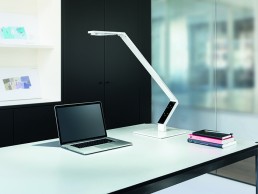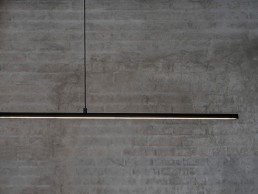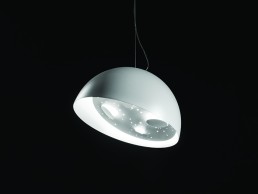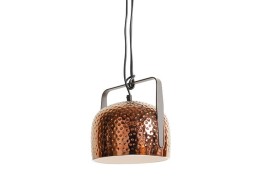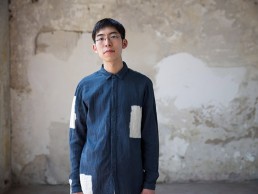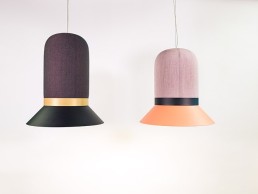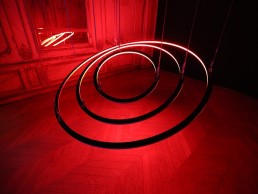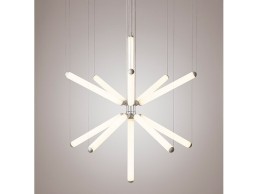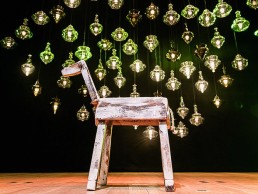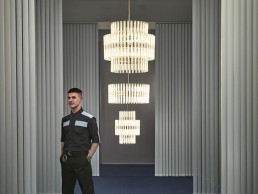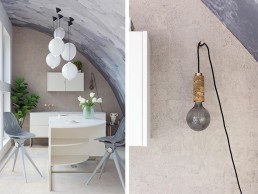Luctra - Table Pro
Table Pro comes with several additional features not present in the basic version. In addition to manual operation, it can be controlled with absolute precision via an app. Based on the answers to five simple questions, the app creates the optimal 24-hour lighting curve, via bluetooth technology.
Light Point - Slim
Slim is an elegant, discreet and efficient light source for the dining or meeting table, with the luminaire appearing as an almost invisible line in the air. The black luminaire, also available in white, is just a single cm in thickness and five cm in width. It is available in three lengths: 120cm, 150 cm and an impressive 180cm.
Knickerboker - Bucola
An aluminium dome, with its divine and endless symmetry, meets and envelopes the starry and glittering sky from the last collection Buchi.
Under the dome vault, the light borns and evenly spreads radiating the surrounding environment with colours ranging from white to black.
Karman - Bag
Feminine, personal, inalienable, the Bag light designed by Baldessari & Baldessari for Karman, portrays the versatility of a real bag: a soft and comfortable spherical cap, sustained by a metal element; the handle allows the light to hook on to the ceiling, stand on the floor, or sit on the table depending on the mood, space or situation.
Hiroyuki Murase
Hiroyuki Murase, Creative Designer of German design label Suzusan, brings a contempory relevance to the centuries old family tradition of Japanese shibori.
The roots of the Suzusan label lie in the Japanese town of Arimatsu, its historical townscape, widely known as one of the most beautiful sceneries in the Fifty Three Stages of the Tokaido. Disocvered by the first Shogun -Tokugawa Leyasu of Okazaki. When Leyasu united Japan, he moved the capital to Edo (now Tokyo) and made it a requirement that all the feudal lords travel to Edo every other year to swear allegiance to him. To aid them on their journey he established 53 stations on the road between Osaka and Edo for them to rest. To ensure their safety, he encouraged the foundation of villages around these stations, one of which was the town of Arimatsu, which was settled in 1608 by just eight families.
While building a castle in Nagoya for his son, Leyasu enlisted workers from all over Japan. One group from Oita brought with them the meticulous practice of folding stitching, binding, plaiting or twisting fabric to give it a three dimensional form named Shibori.
Hiroyuki Murase’s family have been refining textiles in Ariatsu with this traditional shibori technique for over 100 years. Now in their fifth generation, the Murase family regards shibori as a cultural heritage that must be upheld with an endless passion and commitment to perfection, in order to stop the decline of the shibori craft that has been witnessed over the past five decades. At this year’s Light + Building darc were introduced to this unique brand and its remarkable backstory.
Murase set up Suzusan, nine years ago in Dusseldorf after meeting Christian Dietsch at the University of Kunstakademie Dusseldorf to study art. Dietsch was introduced to Shibori by some fabrics Murase had left in their room, which his father had made and exhibited in the UK. Amazed by their three dimensional structure, Dietsch proposed a business idea, using this ancient Japanese technique and applying it to contemporary objects. Murase was unsure at first, he had little interest in joining the family business and wanted to pursue a career in contemporary art until a visit to the Venetian Biennale set his destiny in motion.
“I saw a personal exhibition of interior designer, Axel Vervoordt, more than anything his works were not categorised,” Murase says. “Contemporary European art sat next to old pottery made centuries ago, but overall it looked very beautiful. At that time I was under the impression that beauty was created by artists, but it made me realise that beauty came from other places too. My values changed, I stopped putting the world in boxes and I could see that what my father did back home was exciting.”
In order to sell these labour intensive products, which can only be produced in small batches, Suzusan had to become a luxury niche, establishing itself in Europe before Japan to embrace its new contemporary iteration. Murase used Tekumo-shibori (hand-tied spider web tie) on polyester to create original light coverings for the very first product launch. The duo loaded them in the boot of an old car and drove to boutiques around Europe in the hope that one would buy them. Rejection followed but Murase took the experience as a lesson in marketing, noting the size of his potential customer base and consumer tastes. Now, German brand Suzusan is giving the technique a more contemporary relevance through the development of new and innovative procedures and modern creations, with Murase at the creative helm. “Craftsmen in Arimatsu have pride in themselves. They want to show their skills with highly complex techniques. That’s important but when you put on the garment, sometimes it could turn out to be too overdone. I thought that our products needed to blend into overseas tastes, they need to be sophisticated, yet not too complicated to make because that would stop young people joining the industry, which in turn would stop us developing new talents.”
Applying this knowledge won the brand a place on Leclaireur’s shelves, the prestigious Parisian store that introduced COMME des GARCONS to the European market. Suzusan, launched a fashion line, a homeware line and Suzusan Luminaires, an intricate range of shades that include custom-made coats, which use their three-dimensional surfaces to bring an extra special flair to light. For Murase the coalescence of light and textile was inevitable. “Light is an intangible element, but textile is very tangible, it is close to your skin and life,” he says. “The combination of those two different elements makes a beautiful fusion.”
Now Suzusan is giving the technique a more contemporary relevance through the development of new and innovative procedures and modern creations, Murase’s dream is to keep the ancient tradition of Shibori alive. As well as designing he also lectures and teaches workshops at German universities. “I want more people to know the value of Arimatsu-Narumi Shibori. I want the people and the techniques to last for another fifty hundred years.”
Light Cycle
(US) - US-based PUNCH Architecture and Illuminate Lighting Design transform a dated and dilapidated space in Portland, Oregon into a hip new restaurant experience that perfectly reflects the city's roots and ethos.
The Duniway Portland Hilton hotel in the US is redefining the hotel dining experience through its Jackrabbit restaurant. A return to the heyday of luxurious hotel bars and a snapshot of the best of upscale Portland dining, the hotel caters to locals and travellers alike, with unexpected and memorable menus and experiences.
The design concept for Jackrabbit combines the creative approach of Chef Chris Consentino’s behind the scenes kitchen craftsmanship with the grit, flavour and character that makes Portland one of the country’s premier dining and lifestyle destinations. As with kitchen environments, the ingredients of Jackrabbit’s interiors have been meticulously selected and come together to create vignettes that highlight key areas of use.
Cosentino’s philosophy is to use everything the animal gives us and this has been reiterated in the restaurant design by utilising the entire space, this was further developed by keeping to his holistic approach of simplicity, sustainability, authenticity and craft, with the design embracing Portland and Cosentino’s approach to cooking and lifestyle - working in tandem with the kitchen and bar. The result is a synergy between flavour and atmosphere, place and taste, embodying Portland’s spirit of conviviality.
Punch Architecture was brought on board to work on the restaurant’s interiors, based on the design studio’s existing relationship with Delicious MFG. Having engaged the hotel owners to go over the key directional points regarding the overall feel of the public space, it was established that the bar and restaurant should not feel as though they were located in a hotel space, this in turn influenced the entire public space environment for the hotel. Illuminate lighting design came on board to support Punch’s vision and design, by enhancing the space through discreet architectural lighting design that is functional, but doesn’t have a seemingly noticeable presence. The architectural lighting was there to make the decorative lighting features, which are very prominent in the project, work in such a way that they provided the right amount of sparkle without creating too much glare.
“Thankfully the concept and design brief didn’t change over time and there weren’t any real value engineered revisions that we had to do for this project,” Zak Ostrowski, a Partner at Punch, tells darc. “The decorative lighting elements were key to the design from a conceptual and aesthetic perspective – while also tying in Chef Consentino’s passions and roots. Key considerations were to make sure all of the custom decorative lights were locally made, which they were. We designed the fixtures in line with our design sensibilities – a little rough around the edges, a splash of bling and a general amount of being ‘rad’.”
The bike chandeliers in the dining space came from a discussion about Chef Consentino’s passion for cycling, lighting and Portland. The designers used recycled Schwinn bike frames, blown glass and low rider inspired Dayton rims with old school Castle spikes for the design. “This tied in nicely with our interest in tricked out objects of movement," says Ostrowski. "We added some nice touches of brass for that bling factor and blackened steel to add consistency to the restaurant's overall design.”
The custom designed minimal blackened brass chandelier is a simple rectilinear form that is understated but monolithic. It creates a presence of masculinity and femininity while gently floating above the reclaimed live-edge white oak drink rail at the bar area.
The centrepiece of the main dining room is the large wood and steel box beam.
“We wanted to create this massive object that again floated above the space filled with rich earth tones,” Ostrowski explains. “It reads as a massive felled timber beam with industrial steel brackets, tying into Portland’s logging history and use of wood structural beams and columns for multiple projects. It also ties in nicely with the exposed wood beams at Chef Consentino’s restaurant Cockscomb in San Francisco.”
Each decorative lighting feature was carefully considered for a space that serves different functions in the same location. For example the design for the articulating chandeliers was based on the need to rotate the fixtures to tie in with the private dining rooms, which expand in size. The custom live edge walnut tables can be put together to become one giant bookmatched slab and the designers wanted the lights to do the exact same thing. “We collaborated with Savoy Studio on making this happen,” says Ostrowski. “The independent chandeliers have the ability to become this slick and organic giant 20ins chandelier made out of blackened brass, steel and handblown glass.”
The decorative glass elements are leaf shaped to represent Portland’s lush vegetation and complement the original artwork and leather belt feature wall in the space.
The primary lighting design from Illuminate complements the interior design and enhances the dining experience by layering several lighting components to create a scheme. Architectural light fixtures are hidden among the wooden beams in the ceiling to provide functional lighting for table surfaces, but are discreetly and strategically placed so as to give the decorative fixtures a significant presence. A combination of recessed and stems mount downlights while the precisely calculated beam spreads light over the tables and food on display, while warmer decorative ceiling and wall fixtures provide the glow that complements the interior style. Key features such as brick walls, leather clad walls and burnt wood screens are grazed with tighter beam downlights and linear grazers. A further detailed layer of lighting is added using linear LED fixtures, integrated within display shelving, uplighting shelves above eye level and downlighting shelves below eye level, eliminating any possibility of looking into a bright source of light.
“The lighting scenes in the space are designed to create various moods throughout the day from breakfast to late night and after hour’s settings,” Niha Sivaprased, Senior Designer at Illuminate Lighting Design tells darc. “An added layer of complexity lay in the need to respond to the incoming daylight and the brighter light levels in the hotel lobby. Smaller groups of fixtures are controlled together to achieve higher control granularity allowing for more meticulous lighting scene settings.
“The perfect balance between sparkle and soft light, functional and decorative light, and ambient and accent light fashions an enticing spectacle from the outside and a comfortable ambiance on the inside. At Jackrabbit, light plays a vital role in bridging the gap between the physical space and the human experience within it.
“The space is rich, relaxing and masculine at surface level, but as one peels back the multiple layers of the project; a subtle femininity comes out with the warm materials, artwork and intimate decorative lighting.”
“The project team was able to turn a dated and dilapidated space into a completely new environment that fits into Portland perfectly, while also reflecting Chef Chris Consentino and the hotel’s new direction,” Ostrowski concludes. “It’s one of the coolest Hilton Brand Hotel projects out there and we are proud to have been a part of it.”
BuzziSpace - BuzziHat
Designed by Alain Gilles, this hanging lamp stands out due to its special shape – a top hat. The hat is available in various fabrics and is not just decorative; it consists of sound-absorbing material that absorbs unwanted noise.
BuzziHat is available in various sizes and the colours of the brim and the hat can be customised.
Kinetic - Lights Circular
A ring is a representation of eternity and manifests something that is never-ending. Circular is a chandelier style kinetic light installation. It is composed of three Pixel Rings featuring 1800 individually controlled RGB LED pixels. The rings are suspended from the ceiling by 9 Winch LED with pixel mapping extensions.
Brokis - Puro Sparkle
The symbolic Sparkle shines with noble yet minimalistic geometry and constitutes the centrepiece of any space. The multiple tubes of matte opal or smoke grey glass radiate outward in diffuse light for a magical interior ambience and dynamic. Puro Sparkle comes in three sizes creates an amazing lighting object nearly.
Lasvit win prestigious Milano Design Award
(Italy) - Lasvit's Monster Cabaret competed with 1,500 exhibitions in Milan to win the prestigious Milano Design Award.
The Milano Design Award is given to the installation that best interprets a contemporary design and a future conceptual vision. The ceremony took place at the stage of Teatro Gerolamo, where the award was presented by Milano Design Award’s founder Dino Lupelli and Cristina Tajani, the Councillor of Milan for fashion and design.
"I am happy and honoured that the jury has chosen Lasvit among so many beautiful presentations," said President and founder of Lasvit Leon Jakimič. "We wanted to show the exceptional Monster collection in a different, edgy, daring way. Being given this award just underlines our vision to be the most inspirational glass making company in the world."
Lee Broom presents Observatory in Milan
(Italy) - Lee Broom unveils Observatory in the first of a three-phase launch of new lighting collections for 2018.
Following Lee Broom’s milestone 10-year anniversary in 2017, this year’s launches see the focus return to lighting, which the brand is renowned for. Revealing three new lighting collections, Observatory is Lee Broom’s most progressive work to date with new stellar-inspired designs playing with proportions of vertical and horizontal space, sculptural, spherical form, and the refraction and reflection of light.
Observatory will be presented as a trilogy of shows. Debuting in Milan, the exhibition will then travel to New York in May for NYCxDesign 2018, and to the London Design Festival in September. New lighting designs will be unveiled at each show, building the collection into a substantial body of new work for 2018.
In a significant departure from the conventional design week model of previewing new designs several months before they go on sale, products from Light Years will be available to purchase immediately in-store and online, offering customers instant access to the show and the collection for the first time.
Observatory uses new technology within the collection featuring LED lighting systems and bulbs custom-designed and developed in-house by Lee Broom. Displaying new finishes such as polished chrome, and new interpretations of materials used in past collections, this marks a new direction for Lee Broom.
Lee Broom said: “Observatory has been a fascinating journey for me. I wanted to create a celestial collection of sculptural lighting, which is progressive and experimental using the latest LED technology. Lighting is a fundamental part of my ethos as a designer and will always play a leading role in my work.”
Eclipse
Celestial in both its name and inspiration, the Eclipse light sees mirror-polished stainless steel and acrylic discs interact, dissect and obscure, which both eclipses and reveals its illumination to the viewer at the same time.
Available as a single pendant light, chandelier, table lamp, wall and ceiling sconce, Eclipse has a sculptural silhouette with a mobile-like quality that changes at every angle. Using the refractive properties of an etched 10mm solid acrylic core and in-house designed concealed LED technology to create a diffused
halo, the design highlights Lee Broom’s technical craftsmanship and innovation with his signature mix of classicism and modernity.
Alongside the Eclipse collection, Lee Broom will also unveil Aurora, Orion and Tidal lighting collections at Salone del Mobile.
Aurora
Aurora projects layers of ethereal rings of light created from linear LED light. A scalable chandelier ranging from a 40cm diameter to a 1.5-metre diameter, it is a chandelier of infinite adaptations.
Orion
A simple modular tube light with opposing opaque and solid polished gold spheres which connect and expand horizontally and vertically to create bespoke constellations of light.
Tidal
A polished chrome and opaque acrylic table lamp formed from two balancing hemispheres appearing to be pulled apart by an unseen gravitational force.
The Exhibition
Observatory will be presented in a Grade II listed building in the heart of the Brera design district at Via Lovanio, 6 Milano in a 250-square metre gallery style exhibition space from Tuesday 17th to Sunday 22nd.
2LG Studio re-imagine their Design Studio for the Ideal Home Show
(UK) - 2LG Studio re-imagined their studio in the form of a pod for the Ideal Home Show.
Imagined as a design studio space in the garden of their Victorian South London home with minimalist vibes, ‘The Lovely Pod’ is a mindful workspace that utilises cutting-edge sustainable materials to create a playful yet functional pod that is full of texture - cork, recycled plastics, vegan leather made from waste pineapple leaf fibre, vintage furniture and a minimal kitchen area for creative lunches.
The Lovely Pod brings the outside in with a wall of plants to filter the air of the pod and features clam pendants designed by Daniel Schofield for Decode, wall lights by Dyke and Dean and a brass and cork pendant hanging near the kitchen by NOVE lighting, available in either smoked or plain glass.
The result is a comfortable breakout snug for those much need moments of peace within a busy working day.


